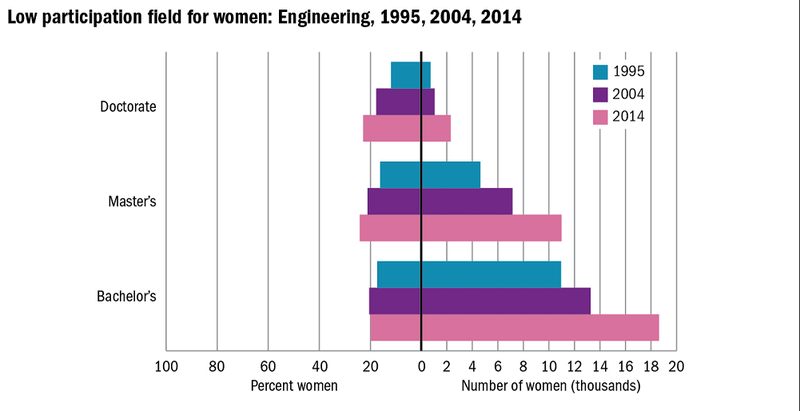Too Few Women in Engineering? Here Are Some Solutions
Here are some ideas for overcoming the gap between the number of women in engineering school versus the number of women engineers in the workforce.
June 16, 2021

For years we’ve seen a discrepancy between the number of women enrolled in college engineering programs and the number of women in the engineering workforce. According to the National Science Foundation (NSF), the percentage of women in undergraduate engineering programs has hovered around 20% for the last 17 years. Yet only 13% of engineers are women according to the Bureau of Labor Statistics.
At first glance, it seems like it will take care of itself in time. The workforce number will catch up. Yet it’s been years and that number isn’t catching up. According to a Society of Women Engineers (SWE) study, only 30% of women who earn bachelor’s degrees in engineering are still working in engineering 20 years later. Thirty percent of women who have left the engineering profession cite organizational climate as the reason.

Some universities are working to combat the low percentage of women in engineering. MIT has a policy of accepting an equal number of men and women into their engineering programs, and thus, the school currently has 49.5% women enrolled in engineering programs. Yet that only addresses the education the bigger problem seems to be on the employment side.
We reached out to Karen Panetta – an IEEE Fellow and author of Count Girls In! – to get some ideas on what employers need to do to help close the discrepancy. Panetta has been working on women in the workforce issues with IEEE.
Design News: While women may be encouraged to enter college engineering programs, do you think that they might be less encouraged to join the engineering workforce?
Karen Panetta: Companies are tweaking their messaging to focus on the ESG [Environmental, Social, and Governance] component of their businesses to recruit diverse populations – including women. Also, many companies are now trying to demonstrate a commitment to inclusive work environments and a culture that fosters innovation and collaboration.
Successful companies are offering more engagement opportunities to students long before they graduate. These include internships, sponsoring challenge events, such as hackathons, and collaboration with professional societies to offer interactions with their corporate role models.
For instance, IEEE-HKN, the honor society of IEEE, has partnered with many companies to provide networking opportunities with their technical leaders and, in return, the companies are gaining access to a promising and diverse group of students. These “pathways” are instrumental in forging early relationships with competitive students.
DN: Are universities – as employers – also working on these issues?
Karen Panetta: More academic institutions are finding it difficult to recruit diverse researchers and aspiring future faculty members, so recruitment efforts are being increased for developing pathways to academia. This is prompting more women to enroll in graduate programs to gain the necessary credentials for an academic career. One major challenge is that women have a narrow view of what kinds of career options are available, especially if they do not have family members who are already in the discipline.
For instance, when I graduated with a computer engineering degree, I thought computer engineers designed and built computers. It was not until I engaged with many IEEE Societies that I was exposed to all the exciting fields I could contribute to, including robotics, health systems, space exploration, and Artificial Intelligence.
DN: Are you seeing barriers for women in the engineering workforce that might discourage them from pursuing or continuing an engineering career?
Karen Panetta: The barriers that continue to plague women in the workforce are the lack of transparency on salary and tangible steps for advancement opportunities.
One predominant issue that women often cite as a barrier is that they are offered lower titles and subsequently lower pay, but responsible for doing all the tasks affiliated with higher-level executive titles and salaries.
The second commonly raised concern is the lack of timely and constructive feedback. Receiving feedback and providing access to resources to help women improve and build their skill sets – not only for the job they are in but for future leadership positions – is important. Many employees do not feel they can gain these experiences within their company and either leave or utilize their professional societies to gain these experiences.
IEEE does this exceptionally well for its members and creates an environment where women are entrusted with leadership roles to grow their skillsets.
DN: Are women in the engineering workforce moving on to non-engineering jobs within the same company?
Karen Panetta: Unfortunately, women – especially young women and girls – are susceptible to taking negative comments from people to heart. This is why positive role models are critical to getting young girls to “run through the finish line” to STEM careers.
This is where the entire theme of my Nerd Girls program came from. Namely, showing the diversity of perspectives and talents of young people bringing innovative solutions to solve our planet’s most challenging issues using technology. Building confidence helps us be resilient to this “noise,” as we call it in engineering, and the stories of role models and their shared experiences help other women to know that they are not alone in the struggles they face and, in the process, gain encouragement, a community of support and a renewed passion for STEM.
I co-wrote a book called Count Girls In! to help parents encourage their children to embrace STEM from birth, even if said parents didn’t have any STEM background.
DN: Are there any other potential reasons for the low percentage of women in engineering jobs?
Karen Panetta: Workplaces are the melting pot of different cultures, lifestyles, and experiences. Companies all promote valuing diversity and try in earnest to provide orientations and resources to help create a level playing field for everyone
However, changing an individual’s mindset to embrace equality and inclusiveness if it was not always at the forefront of one’s values is a difficult challenge. Women will change jobs if they are treated poorly in the workplace – if and when they can financially afford to do so. All too often, women leave engineering because they extrapolate their negative experiences to believe that all engineering fields are infested with the same kind of challenges. Thus, the only way to escape is to leave the field and move on to other fields that have a better reputation for welcoming and respecting the contributions of women and other diverse groups of individuals.
Rob Spiegel has covered manufacturing for 19 years, 17 of them for Design News. Other topics he has covered include automation, supply chain technology, alternative energy, and cybersecurity. For 10 years, he was the owner and publisher of the food magazine Chile Pepper.
About the Author(s)
You May Also Like





